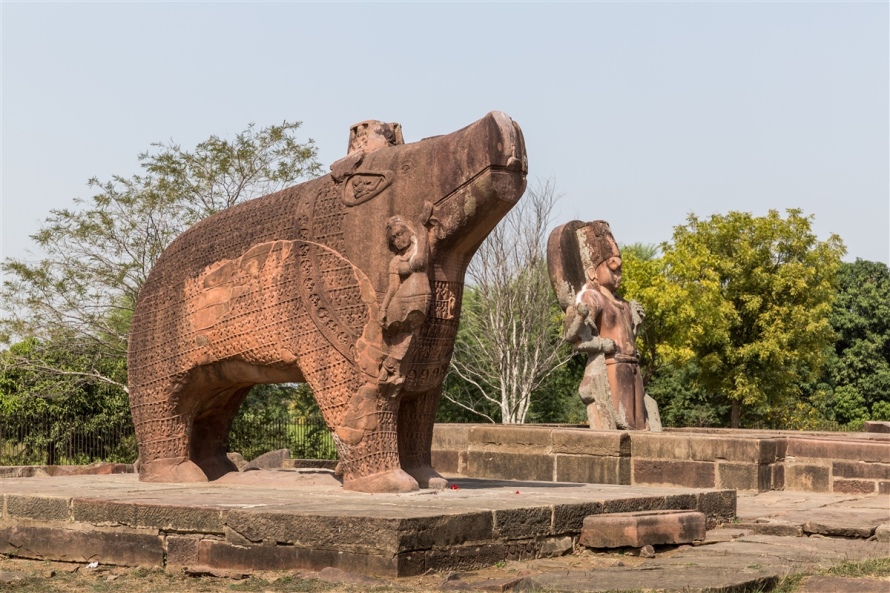
Eran (Sanskrit:ऐरण ) is a small village situated on the south bank of the river Bina, a tributary of the river Betwa, about 100 km north east of the ancient sites of Vidisha, Sanchi and Udayagiri. Eran is probably one of the most ancient towns in India, coins and epigraphs found here give us it’s ancient names of Erakanya, Erakaina and Airikina and it was no doubt a significant stop on the ancient route from Vidisha to Mathura.
Excavations between 1960 and 1965 have revealed settlement deposits dating back to the second millennium B.C. However, the most significant archaeological finds from Eran has to be over 3,000 coins, dating from 300 B.C. through to 100 A.D. The most prevalent type of coins unearthed were square ones, and has contributed to archaeologists believing that Eran was once one of the ancient mints for Indian kingdoms along with Vidisha, Ujjain and Tripuri.
The principal Hindu monuments that can be seen at Eran today are all located in one small complex west of the town. There are the remains of four to five temples here, the main temples standing in a line on a north-south alignment at the far end of the entrance.
Varaha Temple
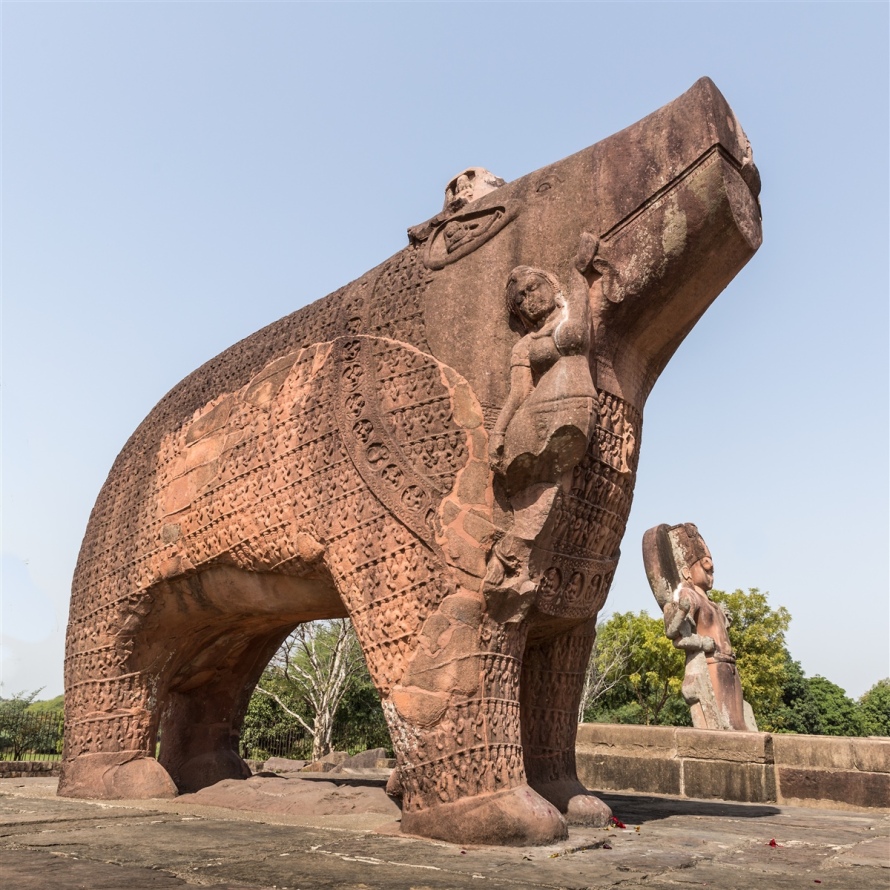
Undoubtedly the most iconic image from Eran, and rightly so. The colossal Varaha at Eran is believed to be the earliest known example of its kind, measuring approx 11 feet high, 5 feet wide and 14 feet in length, and wonderfully decorated with 1,185 figures of sages arranged in twelve rows.
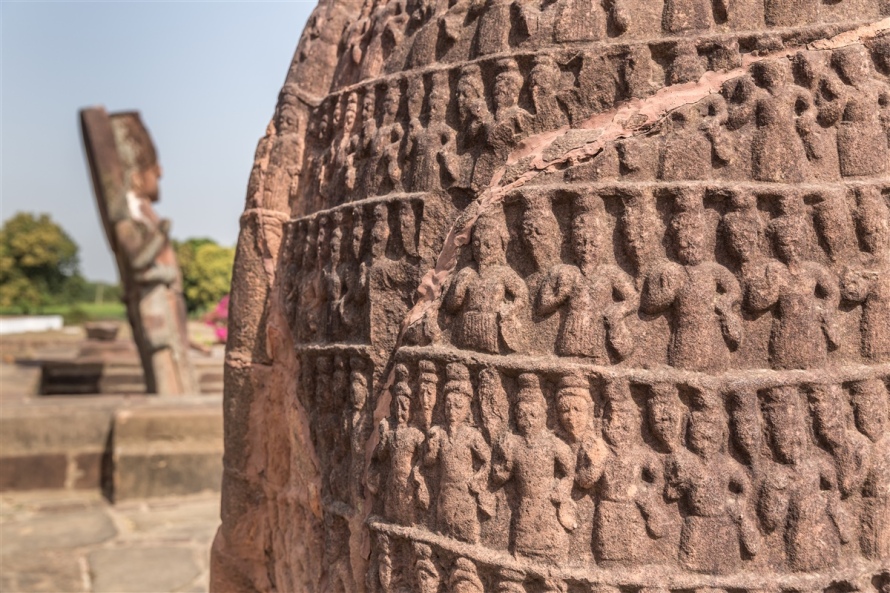
These carvings cover the body, legs, throat, forehead and neck of the Varaha, but the details extend far beyond that. Hanging from the right tusk of Varaha is Bhudevi, in the ears are Vidyadharas (celestial musicians), together with a garland consisting of 28 circles, 27 of them containing an image of male and female figures, the last remaining circle housing a scorpion.
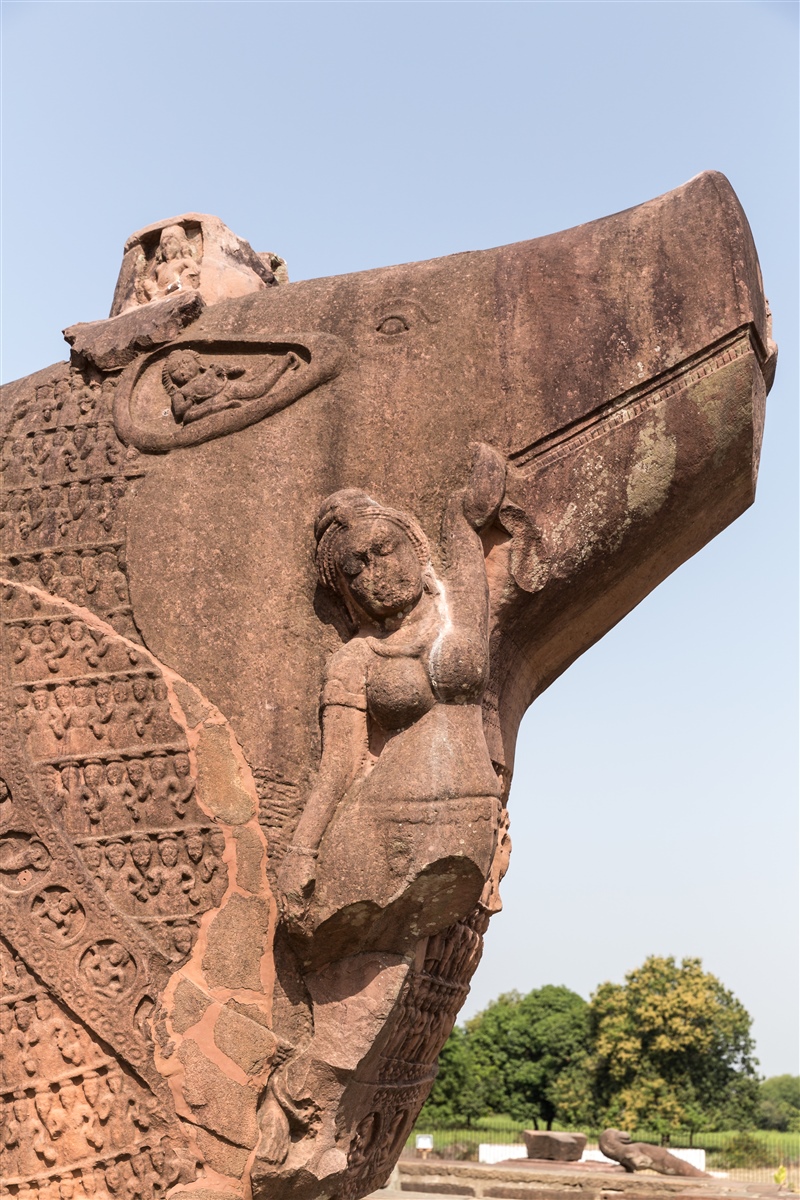
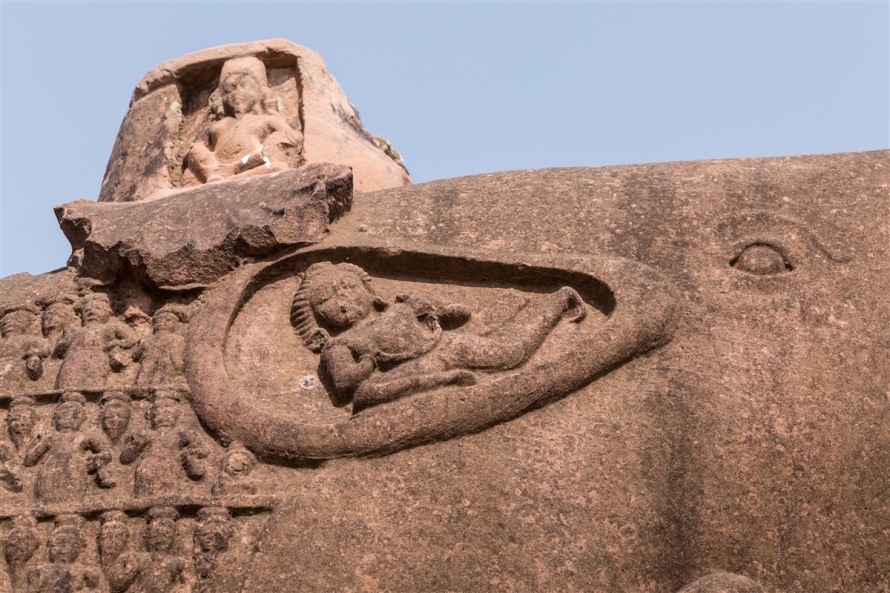
On the chest and throat of the Varaha are four rows of male figures totalling 96 figures in total, each one holding a water pot in one hand. Set in the upper middle of this panel is a single image of Vishnu, the arms sadly now broken off.
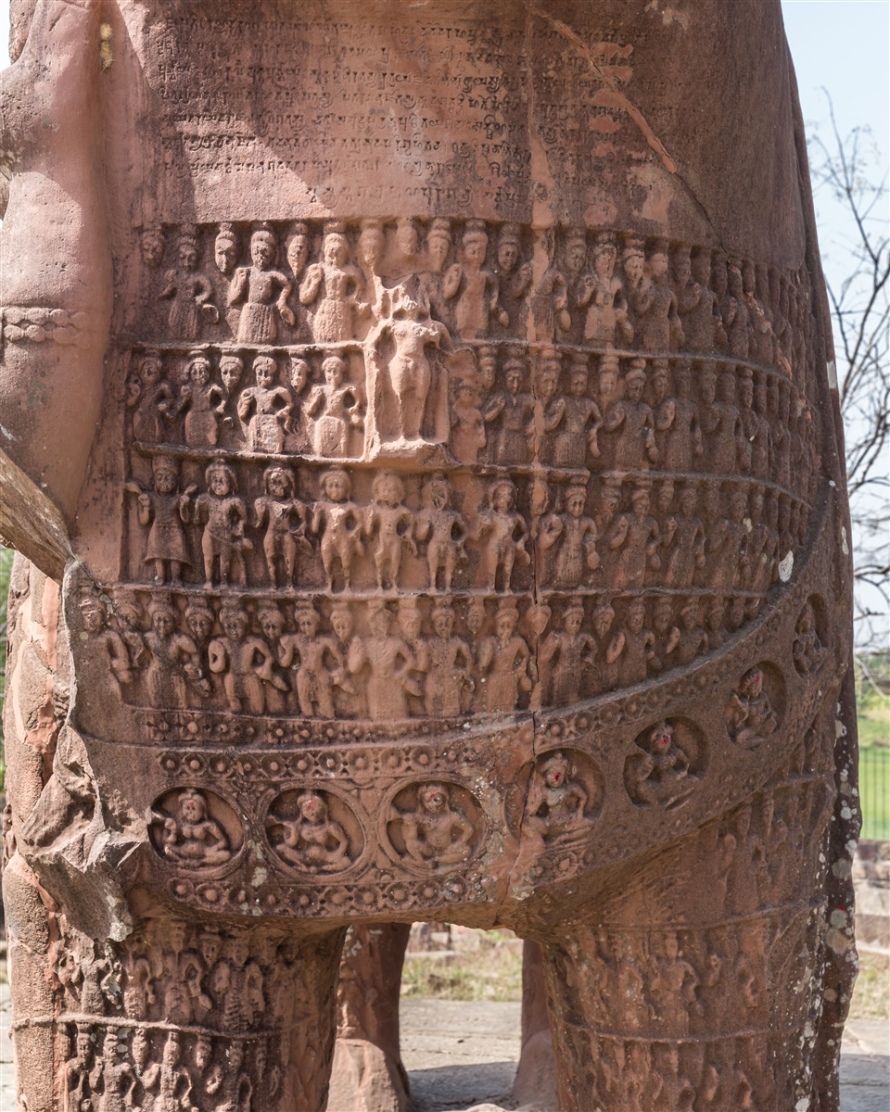
Also on the front chest is a Toramana inscription. This confirms that the Hunas had invaded the north west and displaced the Gupta Empire, which ties down a date for the colossal Varaha to around the early 6th century.
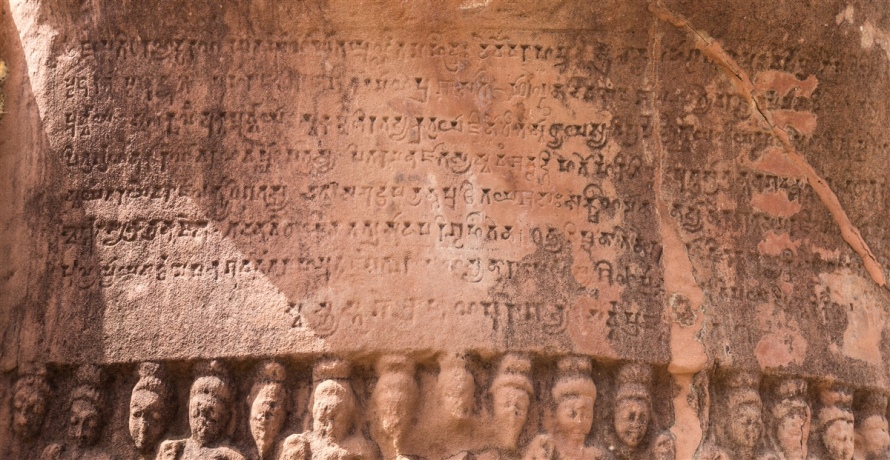
Notice how the Varaha’s tongue is sticking out slightly, and on it is standing a small goddess who has been interpreted as Saraswati (or Vedic goddess Vac).

And don’t forget to look down ! Carved on the floor between the boars legs is a depiction of the ocean, with serpents and sea life.

It’s a magical image, I won’t even start to disclose how many photographs I took of this 🙂
The boar today stands in the open, but it would have once been housed in a small temple, the ruins of which Cunningham first recorded in 1847 and again in 1871. We know there were walls and a mandapa, the remains of which have now been cleared away from the boar, but the footprint of the structure suggests a rectangular temple similar to the Varaha shrine at Khajuraho.
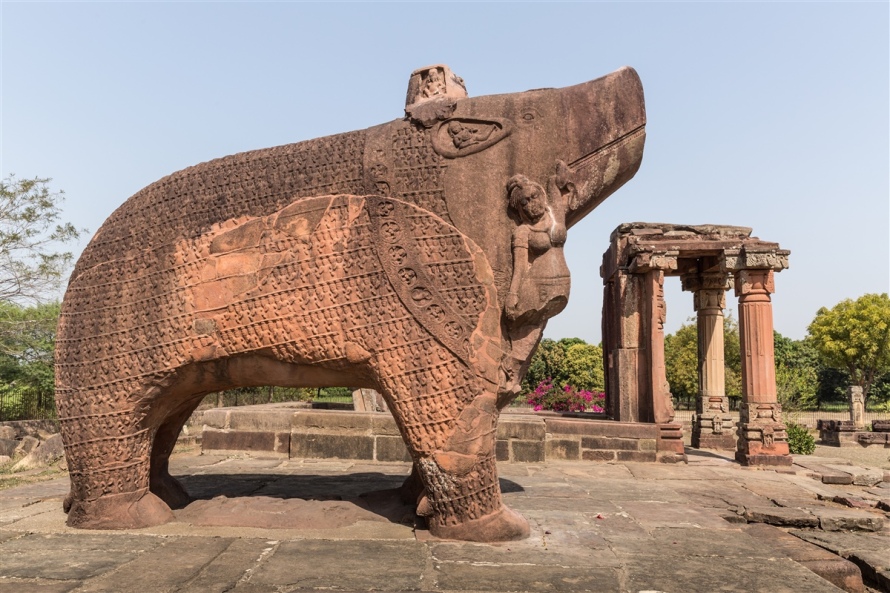
Some distance in front of the Varaha platform is a large stone slab, 6 feet in length and aligned with that temple. On the stone is some large shell script which remains undeciphered. Many believe this to have been the original temple entrance.
Vishnu Temple
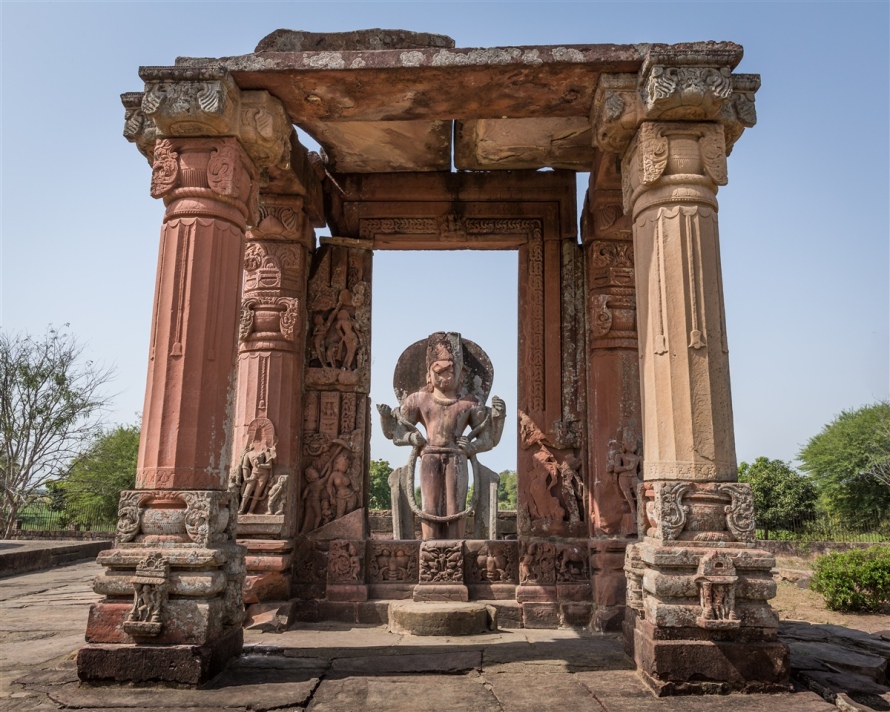
This houses the impressive image of Vishnu, 13 feet high and located in the temple sanctum.
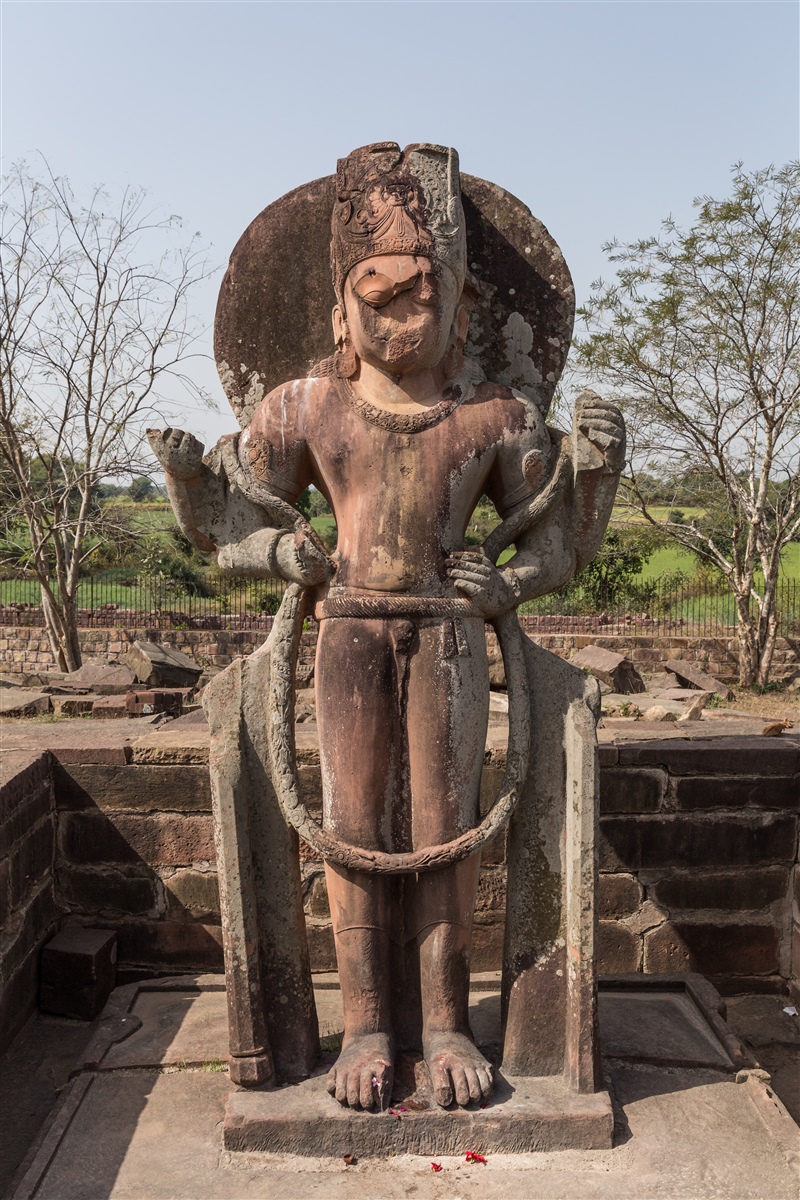
It’s an evocative image, another excuse for my camera to work overtime 🙂 The way Vishnu is framed by the doorway is just so perfect.
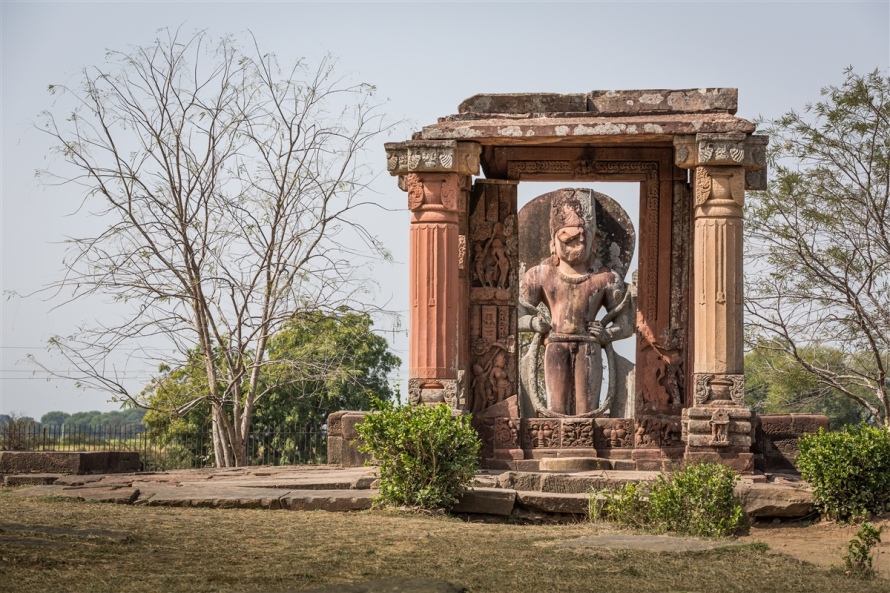
This is the best preserved temple at Eran, and although the roof and walls are missing the decorated sanctum doorway is intact. The door jambs have images of Yamuna and Ganga, river goddesses that are typically found higher up in door jambs from the Gupta period. This has led some experts to believe that the doorway and front mandapa was installed during the Pratihara period, which would date those structures to the 8th or 9th century.
Just like the colossal Varaha, this is a statue that I can’t help returning to and photographing again !
Narasimha Temple
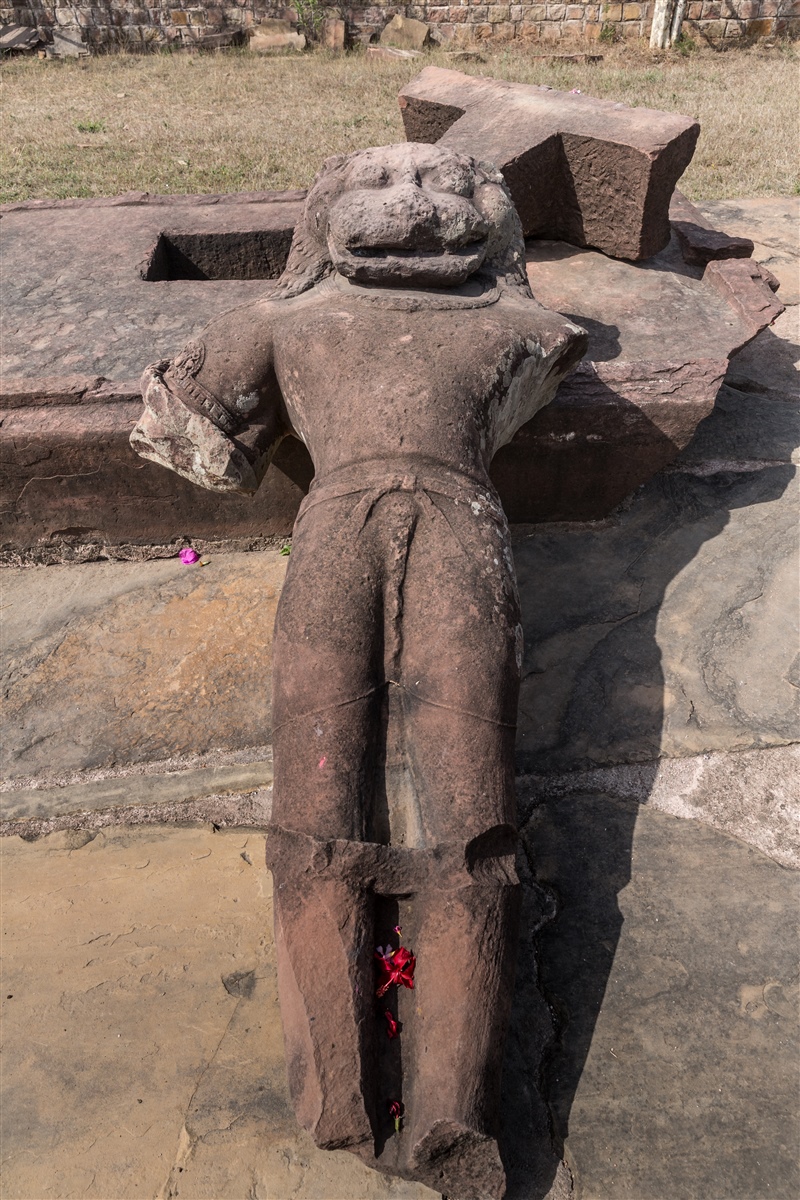
Little remains of this temple structure now, aside from a damaged statue of Narasimha, broken at the knees, resting on a carved slab. Nearby is a pedestal with remains of the feet, originally this statue would have been over 7 feet tall.

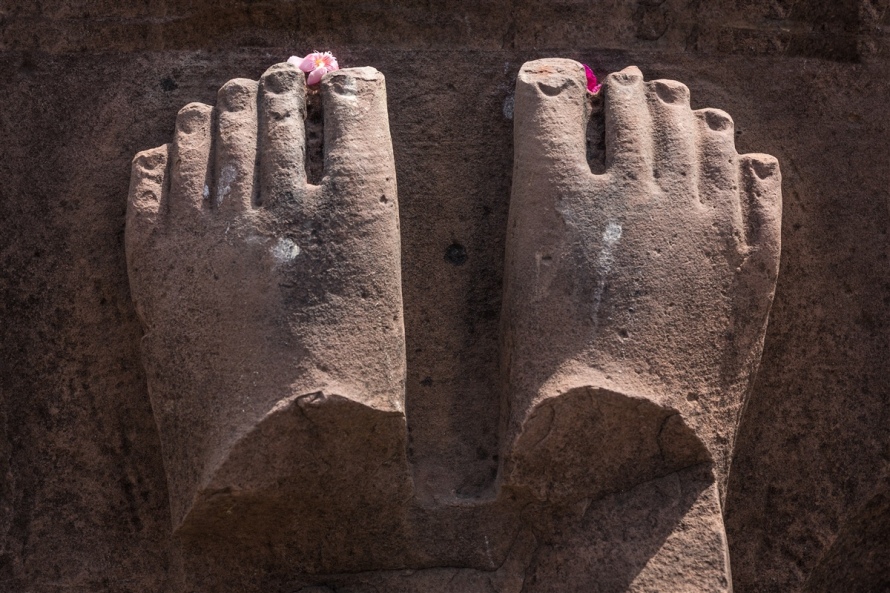
It strikes me that this would be a great opportunity to get him upright again with a little bit of effort and renovation. It seems a shame that this statue is left on the ground when we have both the Varaha and Vishnu statues alongside and correctly in-situ.
Pillar
Also known as the Buddhagupta pillar or Bhima pillar, it stands 43 feet high with a capital in the shape of a reeded bell.
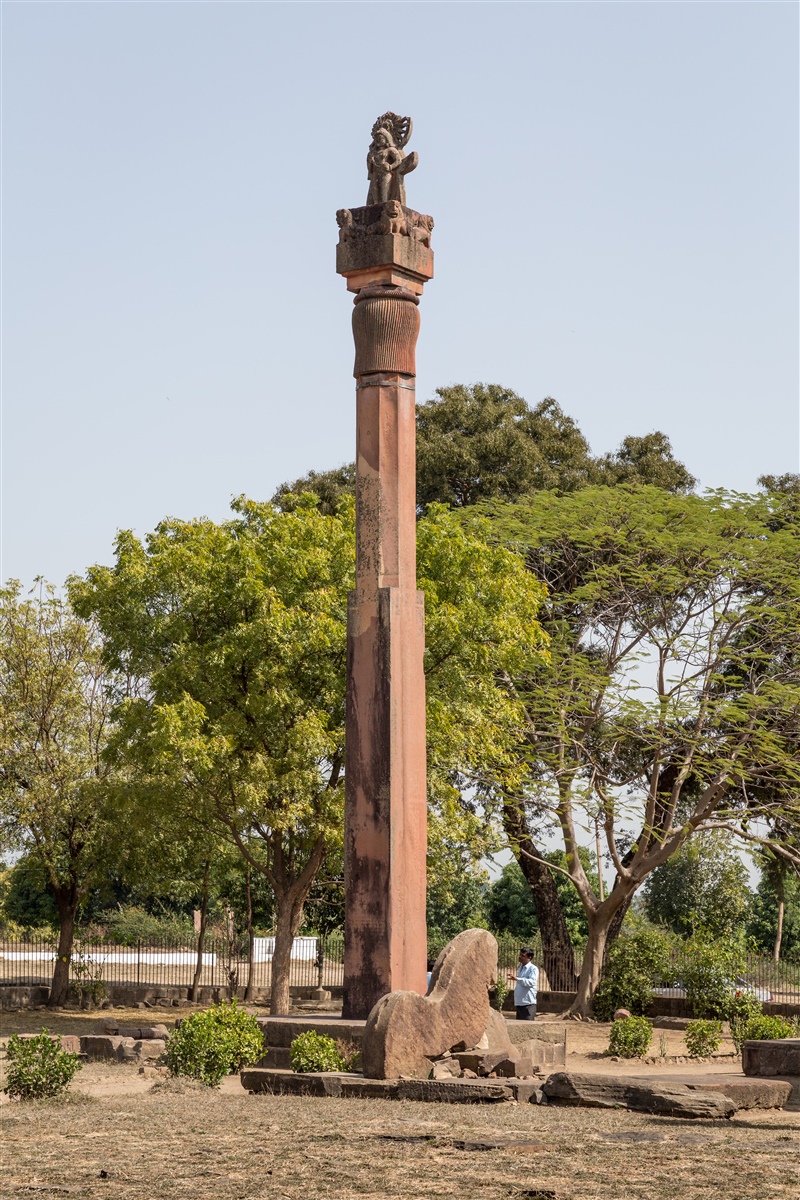
Above this is an abacus with lions, and finally two male figures, 5 feet high standing back to back with a wheeled halo between them.
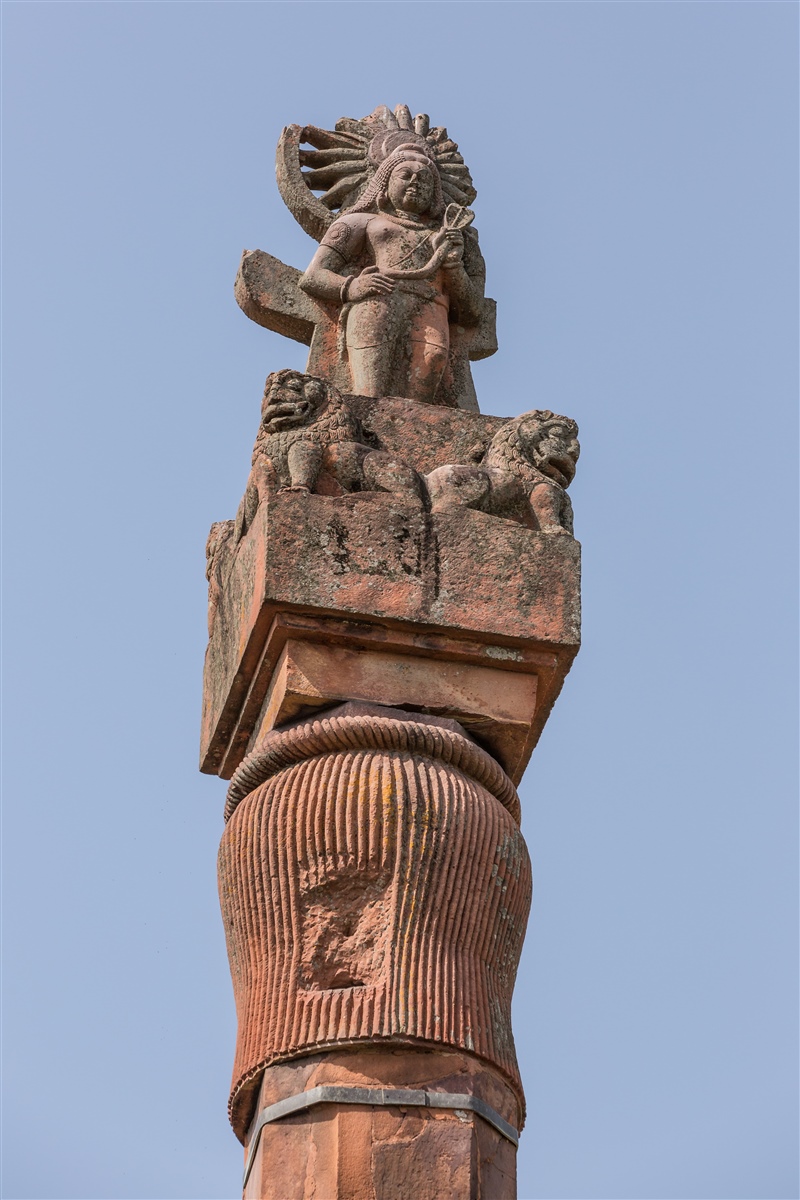
One of the figures is overseeing the temples, the other overlooking the ancient town a little distance away.
On the south side of the pillar is a Sanskrit inscription dating the dedication to around 484 A.D.
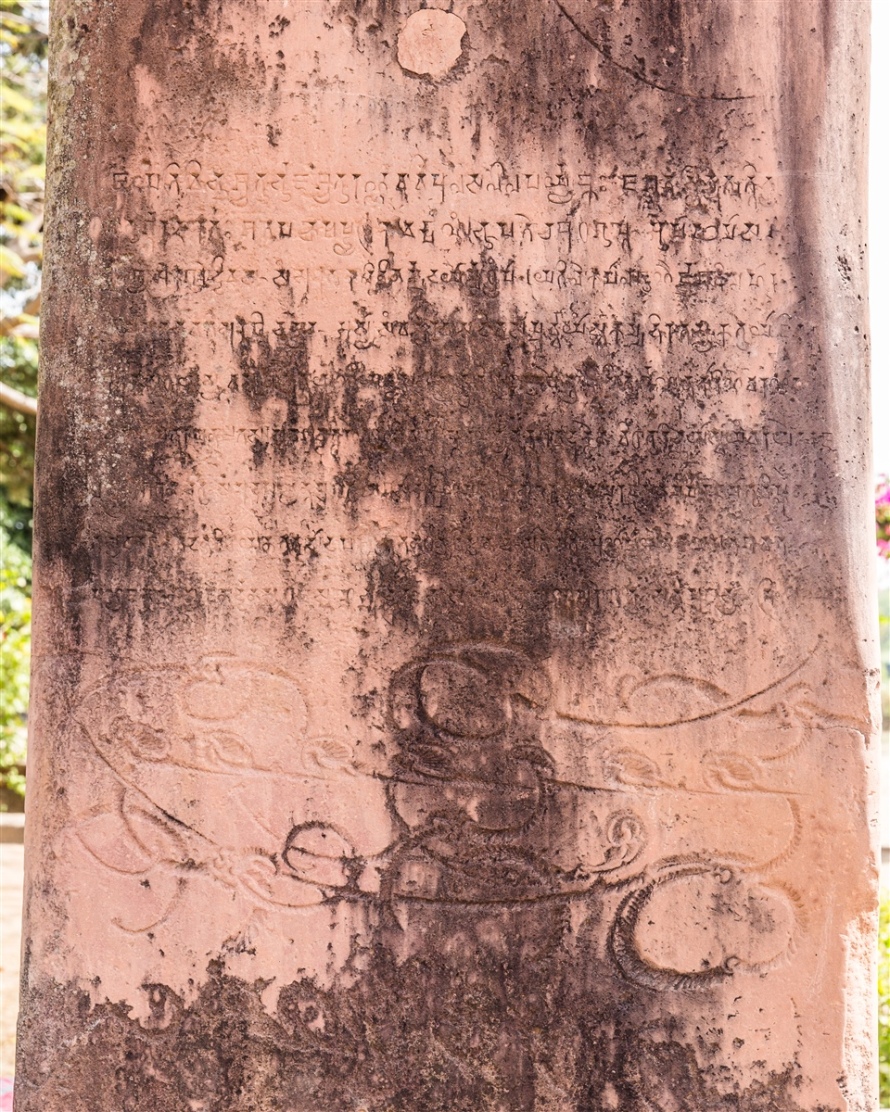
Other sides of the pillar have some interesting carvings as well.
Torana
Just in front of the presumed original entrance of the Vahara Temple with the shell script lies what is believed to be the remains of a torana (Hindu arched gateway). Cunningham searched for broken parts of the pillars, but only found a few broken statues and most of the torana pillars had long gone.
Temple Remains
Just in front of the Narasimha Temple is a curious structure consisting of four pillars set in the middle of a rectangular plinth. On further inspection these would appear to be random pieces of temple architecture that have been collected and placed in this way. Certainly from Cunningham’s map of the temple site there is no evidence of a temple existing exactly where this ‘structure’ is.

These show some equisit carvings, I guess having them still on site for people to see but fixed in this way is perhaps the best way of preserving them.
Eran is a wonderful place to visit; a cluster of immensely interesting temples set within a compact site, located in a relatively remote location. I’d be surprised if you find anyone else there if you visit, and it makes the whole experience all the more special because of that.
You’re welcome to ‘Like’ or add a comment if you enjoyed this blog post. If you’d like to be notified of any new content, why not sign up by clicking the ‘Follow’ button.
If you’re interested in using any of my photography or articles please get in touch. I’m also available for any freelance work worldwide, my duffel bag is always packed ready to go…
KevinStandage1@googlemail.com
Categories: Eran, India, Madhya Pradesh





































Stupendous!! Haven’t been yet. Def. next trip. These are wonderful. I like the little turtle shielded from the elephant feet, which stand safely on lotuspads.
LikeLiked by 1 person
It’s a wonderful remote site, not big, but if you’re traveling nearby it’s well worth a look. I stopped on on my way to Orchha from Bhopal.
LikeLike
Note Kumara with his 3-part crown.
LikeLiked by 1 person
You are doing wonderful service!
LikeLiked by 1 person
Watch this space…plenty more coming… 🙂
LikeLike
You should work together with Praveen Mohan, both of you together can do wonders 🙏
LikeLike
Amazing hobby that surely makes a great many people happy.
LikeLiked by 1 person
A wonderful temple documented beautifully. Loved the photographs.
Similar temple near Eran in MP documented here : https://heart2art.wordpress.com/2020/07/29/__trashed-4/
LikeLiked by 1 person
Thanks Siddi – I was unaware of this other ancient temple near to Eran, so I missed out on seeing it.
LikeLiked by 1 person
Thank you very much for helping us our own heritage through your appreciative camera,
LikeLiked by 1 person
Thank you Vasant. I am blessed to have the opportunity to visit India (although, not this year unfortunately).
LikeLike
Wonderful place to visit Kevin, I had visited Eran on 01/01/2021. I did manage to take few pics as there was almost village fair like atmosphere, with usual worship of Varaha, Vishnu all the assembly of celestial beings. Visiting Eran is an adventure in itself. Had a great time soaking in the sights and sounds in Eran.
LikeLiked by 1 person
It’s a wonderful place, when I visited it was completely empty !
LikeLike
Kevin believe you me. Been there yesterday after a tough drive from Chanderi 😀 enjoyed very much and perhaps clicked one gb worth of images.
Thanks a ton again
LikeLiked by 1 person
Only 1Gb of images 🙂 I’m so happy you enjoyed your experience there !
LikeLike
Have enjoyed reading it, great information and learning~ Thanks Kevin
Would definitely love to visit the site and temple in the near future.
It is a great Blog~ and an amazing collection of images too.
I had borrowed one of your images to use on Twitter.
LikeLiked by 1 person
Thank you Adithya. Note that all my images are copyrighted.
LikeLike
There is a village I think called Surrai off the highway road from Lalitpur to Sagar .There in the desolate ruins dry wry desert like countryside there lies a mysterious green patch apparently the remnants of a large river basin and around this huge span of semi circular green there are this identical remains of Varaha of Narsingh cut on a huge rock face and temples with exquisite artefacts just strewn around and used as stepping stones in courtyards of garments…thee is large scale miserable pillaging and pilfering.. and some local hood ML A who made millions from smuggling out a few unknown yet deciferable beauties.
It was a similar kind of mesmerising experience as you describe.And in the coming few months back then in the year 1995 I as a student of law had seriously thought of turning into a woe begotten angst ridden guilt induced historian of our lost and losing treasures of stories untold unheralded unheard unsung and hitherto unknown.
LikeLiked by 1 person
Interesting ! I might try and find this location, although who knows what the remains are like now
LikeLike
Hi Kevin,
What Shalabh Singh has mentioned are the ruins of Dudhai, complete with ruins of a circular Yogini temple (like Mitaoli) and a gigantic Narsimha cliff face rock-cut statue. I had visited it back in October 2020 and would be glad to share exact details if you ever plan a visit. In fact, the amazing site of Deogarh, Chandpur Jahajpur can also be visited alongside.
LikeLiked by 1 person
This all sounds like the elements for another trip at some point. My trip in early 2022 which was going to be Pune and West Bengal are all on hold now for obvious reasons. It’s very frustrating !
LikeLiked by 1 person
I can relate to your frustration since those of us living in India, travel overseas is quite challenging with an ever-changing set of rules!
If you do start researching the Bundelkhand region, I would also want to add temples of Kadwaya – an inspiration to Khajuraho temples, Thubon, Terahi, etc to the list. In fact, Alexander Cunnigham’s logs provide an exact translation of the inscriptions at many of these temples.
You should most definitely visit West Bengal – stunning temple towns, mosque cities, etc. Many stuck back in the 70’s still. They could really use some excellent documentation like yours!
LikeLike